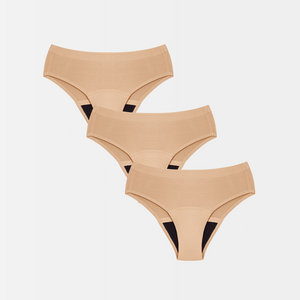Cycle length: What is actually normal?
When searching the internet for a 'normal cycle length,' 28 days is often mentioned. However, a woman's cycle is as individual as she is. The mentioned 28 days are merely a guideline and not a rigid unit of measurement. So what is considered 'normal'? And how long does the period typically last?
How long is the cycle usually?
The cycle refers to the period from the first day of your period to the next menstruation. During this time, the uterus builds up new lining, and the egg matures in the ovaries. Approximately 12-16 days after the first day of the period, around the middle of the cycle, ovulation occurs—the release of the egg from the ovary, which travels to the fallopian tube, waiting for fertilization by sperm. If fertilization does not occur, the egg is shed along with the uterine lining, resulting in menstrual bleeding, and the cycle starts again. In our article Menstruation: How does the menstrual cycle work?, you can read more about the individual phases of the menstrual cycle.
The 28-day cycle: A myth?
The model cycle is exactly 28 days, but who actually has it? And does it necessarily have to be 28 days? Your cycles are perfectly normal if they range between 21 and 34 days. If your cycle length is less than 21 days, you have polymenorrhea, a menstruation that is too frequent. On the other hand, if your menstrual period does not start until after 35 to 45 days, this is called oligomenorrhea, a menstruation that is too infrequent. If there is no bleeding at all, we speak of amenorrhoea. These cycle disorders and cycle fluctuations usually indicate health problems and should therefore be clarified with your gynaecologist if they occur too regularly.
How exactly is the menstrual cycle structured again and what happens during it? Let's start with the desquamation phase, the menstrual phase. This is the easiest to notice. It's followed by the maturation of the egg in the follicular phase, also called the proliferation phase. The follicle-stimulating hormone (FSH) is emitted by the brain and stimulates the maturation of about 40 to 100 follicles. This leads to ovulation. In the ovulation phase, luteinising hormone (LH) is then released and oestrogen levels rise. The last phase is the secretion phase or luteal phase. During this time the uterus is being prepared. The corpus luteum develops from the follicle, the former shell of the egg. Under the influence of LH, it produces the hormone progesterone. This leads to the remodelling of the uterine lining to accommodate a fertilised egg. The blood supply to the uterine lining is increased by the formation of vessels, mucous vesicles and supporting tissue structures build an "egg bed" for an egg fertilised by sperm, the sperm cell. The uterine canal (cervix) narrows after ovulation and the cervical mucus becomes more solid. The luteal hormone progesterone causes a slight increase in body temperature. Your body also prepares for menstruation and you notice PMS symptoms like mood swings, which are probably triggered by hormone imbalances.
Cycle Length: How long does the period last?
It's probably no surprise, but the duration of menstruation is also highly individual and varies from woman to woman. However, there is a general guideline: It is typically considered to last between three to seven days.
If you have a long and heavy flow and are looking for a sustainable and reliable period product, our period underwear keeps you dry and fresh even during heavy menstrual bleeding:
However, sometimes you may experience a light period, while other times it may be heavier. And this can vary from cycle to cycle. The female body is not a machine that follows exact rhythms, and that's what makes it so wonderful!
What influences the cycle length
Various factors can influence the length of your cycle, such as age, lifestyle and stress. Your hormone balance also changes during puberty and the menopause, which affects the length, duration and frequency of your cycle. Do you have endometriosis or PCO syndrome? These factors can also affect your cycle.
Myomas are another factor that can affect your cycle. Myomas are growths that occur in the muscle layer of the uterus and are the most common type of good tumour in women. They usually only cause symptoms when they reach a certain size, such as particularly prolonged and heavy bleeding, period pain or spotting.
How to calculate the cycle length?
Have you ever thought about how long the interval is between your ovulation days and your menstruation days? If this cycle duration is shorter than ten days, you can suspect a progesterone deficiency. Some people feel their ovulation, the so-called mid-pain, and can classify it exactly. You can find all the important information in our ovulation calculator. Despite the name mid-pain, ovulation does not necessarily occur in the exact half of the cycle.
By using a cycle calendar, women can keep track of when their first day of menstruation occurs and better estimate their fertile days. During this process, some women may discover that their individual cycle does not always last 28 days but perhaps only 25 or 35 days. A woman's cycle can vary in length, even lasting longer. It fluctuates throughout a woman's life and can change with age. A long-term study conducted by the research project on natural family planning (NFP) clearly shows that the cycle length of approximately 60% of the surveyed women varies by one week or more within a year.
As is often the case, hormones play a significant role in these variations. They regulate a woman's cycle. Since hormone levels change in individuals at different stages of life, the female cycle is not exact but characterised by fluctuations.
This is precisely why cycle calendars and fertility calculators are useful for women trying to conceive. They provide a good overview of the individual cycle, whether you are trying to get pregnant, are already pregnant, or simply want to better understand your body. We also recommend various apps that allow you to track and monitor your cycle. In these apps, you can also record your body temperature, which is relevant because a woman's body temperature slightly increases during ovulation and fertile days.
























